
The ide, or orfe, is a freshwater fish of the family Cyprinidae found in larger rivers, ponds, and lakes across Northern Europe and Asia. It has been introduced outside its native range into Europe, North America, and New Zealand. It is a popular ornamental fish, usually kept in outdoor ponds in temperate regions from which it often escapes.
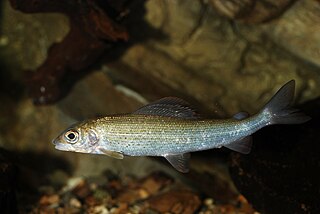
Thymallus thymallus, the grayling or European grayling, is a species of freshwater fish in the salmon family Salmonidae. It is the only species of the genus Thymallus native to Europe, where it is widespread from the United Kingdom and France to the Ural Mountains in Russia, and Balkans on the south-east, but does not occur in the southern parts of the continent. It was introduced to Morocco in 1948, but it does not appear to have become established there.

The round goby is a euryhaline bottom-dwelling species of fish of the family Gobiidae. It is native to Central Eurasia, including the Black Sea and the Caspian Sea. Round gobies have established large non-native populations in the Baltic Sea, several major Eurasian rivers, and the North American Great Lakes.
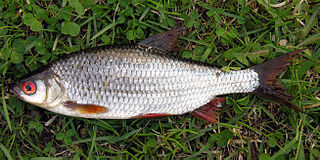
The roach, or rutilus roach, also known as the common roach, is a fresh- and brackish-water fish of the family Cyprinidae, native to most of Europe and western Asia. Fish called roach can be any species of the genera Rutilus and Hesperoleucus, depending on locality. The plural of the term is also roach.
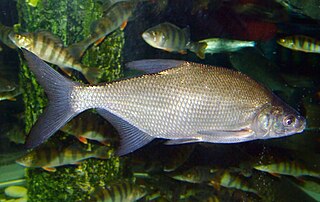
The common bream, freshwater bream, bream, bronze bream, carp bream or sweaty bream, is a European species of freshwater fish in the family Cyprinidae. It is now considered to be the only species in the genus Abramis.

The European seabass, also known as the European bass, sea bass, common bass, white bass, capemouth, white salmon, sea perch, white mullet or sea dace, is a primarily ocean-going fish native to the waters off Europe's western and southern and Africa's northern coasts, though it can also be found in shallow coastal waters and river mouths during the summer months and late autumn. It is one of only six species in its family, Moronidae, collectively called the temperate basses.

The European bitterling is a temperate freshwater fish belonging to the subfamily Acheilognathinae of the family Cyprinidae. It originates in Europe, ranging from the Rhone River basin in France to the Neva River in Russia. It was originally described as Cyprinus amarus by Marcus Elieser Bloch in 1782, and has been referred to in scientific literature as Rhodeus sericeus amarus. It is known simply as "the bitterling" in its native range, where it is the only species of its genus Rhodeus, and sometimes in the scientific literature, also, but this is technically wrong, being a leftover from the times when the European bitterling was united with its Siberian relative, the Amur bitterling, in R. sericeus. Properly, "bitterling" can refer to any species of Acheilognathus or Rhodeus.
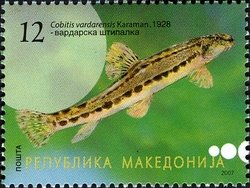
Cobitis vardarensis, the Vardar spined loach, is a species of ray-finned fish in the true loach family Cobitidae.

Pelecus cultratus, commonly known as the ziege, sichel, sabre carp or sabrefish, is a cyprinid fish species from Eastern Europe and adjacent Asian regions, the only one in its genus, inhabiting the lower reaches of rivers and brackish waters in the eastern Baltic Sea, Black Sea, Caspian Sea and Aral Sea basins. The ziege having no major threats, the IUCN lists it as being of Least Concern.
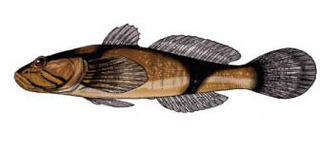
Benthophiloides brauneri is a species of goby, a benthophilic fish native to the fresh and brackish waters of the Black Sea, the Caspian Sea and the Sea of Azov as well as their surrounding rivers and estuaries. Despite the wide distribution, very few observations overall of this fish exist, and just one from the Caspian basin. It has been found in still waters at depths down to around 15 metres (49 ft). Males of this species can reach a length of 7.2 centimetres (2.8 in) SL while females only reach 5.1 centimetres (2.0 in) SL. This fish only lives for one year.
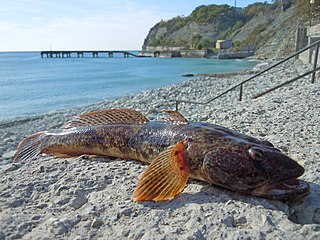
Mesogobius batrachocephalus, the knout goby or toad goby, is one of the species of gobiid fish native to the Black Sea and the Sea of Azov basins. It lives in estuaries and brackish water lagoons, occasionally in fresh waters, such as the coastal Lake Siutghiol in Romania. It prefers areas near cliffs with sandy, shelly or rocky substrates at depths of from 20 to 60 metres, sometimes down to 100 metres (330 ft). The knout goby is a piscivore. It can reach a length of 34.5 centimetres (13.6 in) SL and weight of 600 grams (1.3 lb). Maximum known age is eight years.

The Syrman goby is a species of goby native to marine, brackish and probably fresh waters of the Black Sea, the Sea of Azov and the Caspian Sea basins. They inhabit inshore waters with substrates composed of shell fragments, sand, mud or muddy sand. This species can reach a length of 24.5 centimetres (9.6 in) TL.

Proterorhinus marmoratus is a species of gobiid fish, a tubenose goby native to the brackish water parts of the Black Sea and the Sea of Azov, near the coasts of Bulgaria, Georgia, Romania, Ukraine and Russia. Also it is found in the Marmora Sea (Turkey). It can reach a length of 11.5 centimetres (4.5 in) TL.

The Chornaya tubenose goby is a species of goby endemic to Crimea, Ukraine where it is only found in a short stretch of River Chornaya. Water is extracted in large quantities for irrigation could cause the stream to completely dry out in summer and thus poses a critical risk of extinction in a near future.

The western tubenose goby is a species of goby native to fresh waters of the Black Sea and Aegean Sea basins. It has recently spread as an invasive species to Central and Western Europe and to North America. Previously Proterorhinus semilunaris was considered as a junior synonym of Proterorhinus marmoratus, but was confirmed as a distinct species based on molecular analysis.

The mushroom goby is a species of goby native to the Black Sea where it can be found along the coasts from Bulgaria to the Crimea. Mostly a species of marine and brackish waters, it is known to enter fresh waters in the delta of the Danube River. This species prefers inshore waters with rocks or fallen trees. This species can reach a length of 20 centimetres (7.9 in) TL.
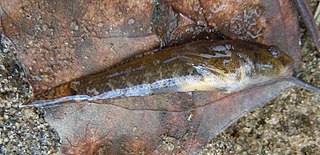
Proterorhinus semipellucidus is a species of gobiid fish, a tubenose goby originally described from the Gharasu River near Gorgan Bay of the Caspian Sea in Iran. Following the systematic decomposition of the tubenose gobies it was suggested to be a more widespread and invasive taxon distributed in the fresh waters of the Caspian Sea basin. It may be the same species as that known as Proterorhinus nasalis.

The stellate tadpole-goby is a species of gobiid fish native to the basin of the Sea of Azov where it occurs in the Gulf of Taganrog and limans of the eastern coast. It also lives in the lower Don River up to the Tsimlyansk Reservoir. It occurs in fresh and brackish waters of depths greater than 3 metres (9.8 ft), preferring shallow coastal lagoons and lowland rivers. Males can reach a length of 13.5 centimetres (5.3 in) TL while females only reach 11 centimetres (4.3 in) TL.
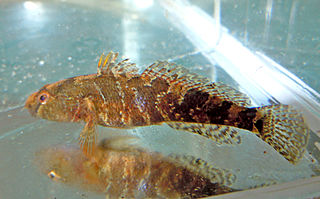
Proterorhinus is a genus of fishes, known as the tubenose gobies. These gobiid fish are native to Eurasia where they occur in the region of the Caspian and Black seas, inhabiting marine, brackish and fresh waters. The species Proterorhinus semilunaris was introduced to the St. Clair River in Michigan during the late 1990s. Until recently, the genus was considered monotypic, comprising only the tubenose goby. Following molecular and further morphological investigations it has been split into several taxa, with distinct distributions in marine vs. fresh waters and in the Black Sea vs. Caspian Sea basins.
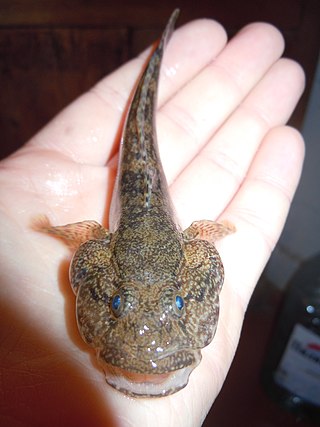
Ponticola gorlap, or the Caspian bighead goby, is a species of goby, a benthic fish native to the Caspian Sea basin. It is widespread in lower parts of many rivers in Iran, and also found in Azerbaijan and Turkmenistan. In Russia, it occurred in the lowest part of the Volga River up to Astrakhan until 1977, but has thereafter spread upstream. In 2000 it was recorded as being established in the Ivankovo and Rybinsk Reservoirs in the Moscow region, and already invaded the Don drainage by way of the Volga-Don Canal in 1972. This species occurs in sheltered environments, such as inshore fresh or brackish waters of estuaries, lagoons, lakes and large rivers, where it prefers habitats with a well vegetated rock or firmly packed sand substrate. It can reach a length of 20 centimetres (7.9 in) SL, and a common size is 12 centimetres (4.7 in) SL.





















